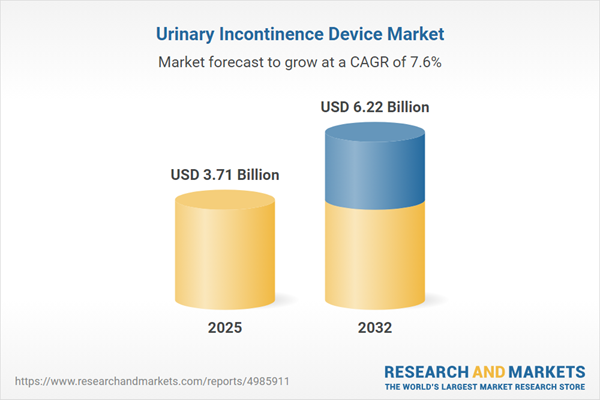Speak directly to the analyst to clarify any post sales queries you may have.
The urinary incontinence device market is undergoing rapid transformation as patient preferences, regulatory shifts, and technological breakthroughs converge. Senior decision-makers require nuanced intelligence to effectively navigate the complexities and opportunities shaping this evolving environment.
Market Snapshot: Urinary Incontinence Device Market Size and Growth
The global urinary incontinence device market grew from USD 3.46 billion in 2024 to USD 3.71 billion in 2025. This sector is projected to maintain a robust trajectory, achieving a CAGR of 7.60% and reaching USD 6.22 billion by 2032. The market’s momentum is propelled by factors such as aging demographics, increasing awareness, and expanding healthcare coverage, which together are broadening the patient base for urinary incontinence solutions.
Scope & Segmentation
This market research provides a comprehensive analysis of critical sub-segments and geographies. Key segmentation includes:
- Device Types: External devices (catheters, collectors & drip collectors, penile clamps), internal devices (artificial urinary sphincters, pessaries, sacral nerve stimulation devices, urethral inserts, vaginal slings).
- Material Types: Latex, polymer-based materials, silicone.
- Technologies: Electrical stimulation devices, mechanical devices, surgical implants.
- Gender Focus: Female, male.
- Form: Disposable, reusable.
- Age Groups: Adult, pediatrics.
- Clinical Applications: Functional incontinence, overflow incontinence, stress incontinence, urge incontinence.
- End Users: Ambulatory surgical centers, homecare settings, hospitals & clinics, long-term care facilities.
- Distribution Channels: Hospital pharmacy, offline pharmacy, online sales channels.
- Geographies: Americas (North America: United States, Canada, Mexico; Latin America: Brazil, Argentina, Chile, Colombia, Peru); Europe, Middle East & Africa (Europe: United Kingdom, Germany, France, Russia, Italy, Spain, Netherlands, Sweden, Poland, Switzerland; Middle East: United Arab Emirates, Saudi Arabia, Qatar, Turkey, Israel; Africa: South Africa, Nigeria, Egypt, Kenya); Asia-Pacific (China, India, Japan, Australia, South Korea, Indonesia, Thailand, Malaysia, Singapore, Taiwan).
- Leading Companies: Aeroflow Inc., Amber Therapeutics, Attends Healthcare Products, Avanos Medical, Avation Medical, B. Braun SE, Becton, Dickinson and Company, BioDerm, Boston Scientific Corporation, Caldera Medical, Coloplast A/S, Contipi Medical, ConvaTec Group PLC, Essity AB, Hollister Incorporated, Johnson & Johnson Services Inc., Kimberly-Clark Corporation, Laborie, Life360 Innovation, Medtronic PLC, Olympus Corporation, Ontex Group NV, Pelvital USA Inc., PROMEDON GmbH, Stryker Corporation, Teleflex Incorporated, Watkins-Conti Products, Inc.
Key Takeaways for Senior Decision-Makers
- Patient-centric design is a central focus, with preference for comfort, adaptability, and minimally invasive options driving product innovation and device architecture.
- Technology integration, such as electrical stimulation and smart sensor features, is redefining continence management and expanding clinical pathways.
- Collaborations and mergers between device companies and technology providers are accelerating product development, with an emphasis on combining device therapy with digital monitoring.
- Cost efficiency and long-term value are prioritized, leading to modular, reusable designs and closer alignment with payer outcomes and digital health models.
- Regional dynamics, including mature reimbursement frameworks in the Americas and rapid market expansion in Asia-Pacific, require tailored entry strategies for lasting market relevance.
- Manufacturers are responding to evolving care models, including the growth of outpatient and home-based treatment via telehealth and remote monitoring solutions.
Tariff Impact on Supply Chains and Cost Structures
Recent United States tariff measures have significantly affected component and raw material imports, particularly for silicone and polymer-based supplies sourced internationally. In response, manufacturers have accelerated nearshoring initiatives, engaged with domestic material partners, and explored bio-based alternatives to mitigate increased duties. These moves are fundamentally reshaping sourcing, inventory management, and cost structures. Negotiations between device makers and healthcare payers have intensified, with ongoing trade fluctuations prompting strategic alliances to maintain both supply resilience and product quality.
Methodology & Data Sources
This report relies on a robust research methodology combining extensive secondary research with primary qualitative interviews. Insights are drawn from regulatory filings, industry white papers, and discussions with urologists, continence care specialists, supply chain leaders, and reimbursement experts. Analytical triangulation ensures that recommendations are balanced and actionable for executive decisions.
Why This Report Matters
- Enables targeted investment and product pipeline decisions through actionable analysis of emerging technologies and evolving patient demands in the urinary incontinence device market.
- Supports risk mitigation and cost control by exploring supply chain vulnerabilities, tariff impacts, and sourcing strategies tailored for global operations.
- Guides competitive positioning via detailed examination of key players, collaborative dynamics, and regional adoption trends, empowering senior leaders to shape effective market entry and expansion strategies.
Conclusion
The urinary incontinence device market is defined by patient-centered innovation, adaptive supply strategies, and region-specific approaches. Decision-makers can leverage these insights to align resources, foster resilience, and capture opportunities in this dynamic sector.
Additional Product Information:
- Purchase of this report includes 1 year online access with quarterly updates.
- This report can be updated on request. Please contact our Customer Experience team using the Ask a Question widget on our website.
Table of Contents
3. Executive Summary
4. Market Overview
7. Cumulative Impact of Artificial Intelligence 2025
Companies Mentioned
The companies profiled in this Urinary Incontinence Device market report include:- Aeroflow Inc.
- Amber Therapeutics
- Attends Healthcare Products, Inc. by Domtar Corporation
- Avanos Medical, Inc.
- Avation Medical
- B. Braun SE
- Becton, Dickinson and Company
- BioDerm, Inc.
- Boston Scientific Corporation
- Caldera Medical
- Coloplast A/S
- Contipi Medical
- ConvaTec Group PLC
- Essity AB
- Hollister Incorporated
- Johnson & Johnson Services Inc.
- Kimberly-Clark Corporation
- Laborie
- Life360 Innovation, Inc.
- Medtronic PLC
- Olympus Corporation
- Ontex Group NV
- Pelvital USA Inc.
- PROMEDON GmbH
- Styker Corporation
- Teleflex Incorporated
- Watkins-Conti Products, Inc.
Table Information
| Report Attribute | Details |
|---|---|
| No. of Pages | 192 |
| Published | November 2025 |
| Forecast Period | 2025 - 2032 |
| Estimated Market Value ( USD | $ 3.71 Billion |
| Forecasted Market Value ( USD | $ 6.22 Billion |
| Compound Annual Growth Rate | 7.6% |
| Regions Covered | Global |
| No. of Companies Mentioned | 28 |









